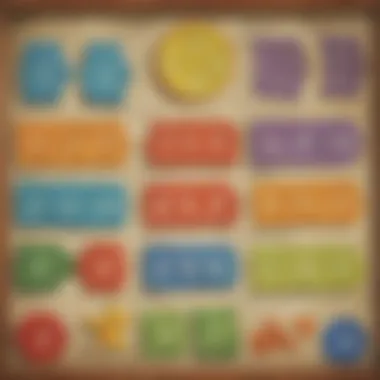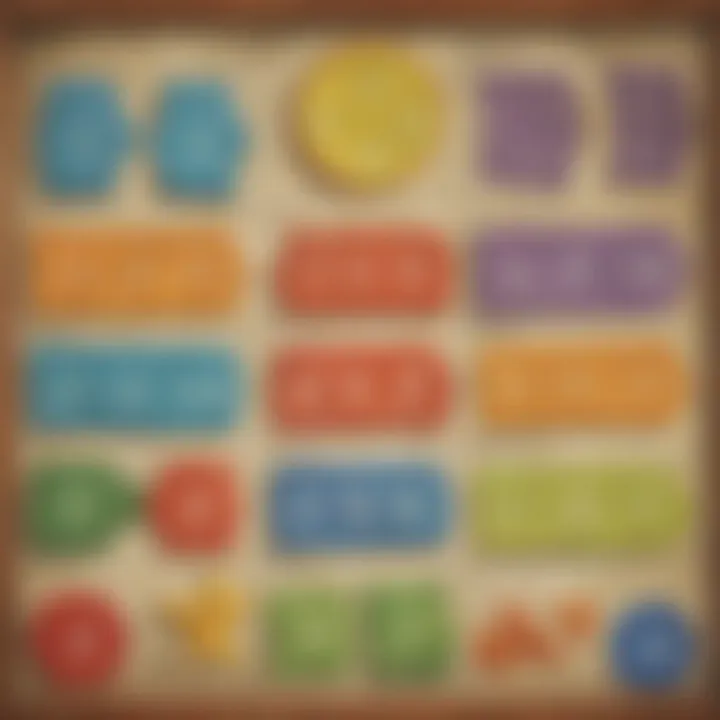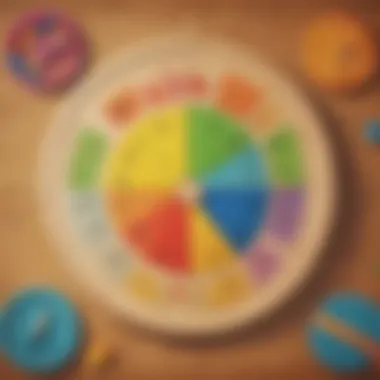Top Math Resources for Engaging Fifth Graders


Intro
In an age where digital resources abound, finding the right math websites tailored for fifth graders can be both a challenge and an opportunity. Fifth grade is a pivotal year in a child's education, where math concepts become more complex and critical thinking begins to take root. Parents and educators play an essential role in navigating these resources to enhance learning outcomes. This article examines several key platforms that provide engaging and educational math content suited for this age group. The goal is to support the mathematical journey of fifth graders by identifying tools that foster understanding and skill development.
Creative Activities
Creative activities can make math more relatable and enjoyable for fifth graders. Engaging in hands-on experiences not only solidifies their understanding of mathematical concepts but also promotes critical thinking.
Craft Ideas
Crafting allows students to visualize math principles. Simple ideas include creating geometric shapes using colored paper or employing string to demonstrate angles. Each craft can connect back to lessons on symmetry or area, allowing children to interact with these concepts physically.
Step-by-Step Guides
For effective execution, step-by-step guides can be provided. For instance, when creating a geometric shape art piece, the instructions can detail how to measure, cut, and assemble pieces. This helps reinforce the mathematical principles behind the activities.
Educational Value
Engaging in these creative tasks enhances students’ learning through active participation. As they create and explore, they are likely to remember better. Such activities also encourage collaboration, as students can work in groups, fostering social skills alongside academic ones.
Fun Quizzes
Quizzes offer an excellent way for fifth graders to solidify their math knowledge. They provide immediate feedback and can be a fun and interactive experience.
Quiz Topics
ElemFun presents a range of topics. Students can explore fractions, decimals, geometry, and problem-solving skills. Each quiz targets specific standards set for fifth graders.
Question Types
The variety in question types keeps students engaged. Multiple-choice questions, true or false statements, and fill-in-the-blank formats challenge students differently, catering to diverse learning preferences.
Knowledge Reinforcement
Quizzes not only test knowledge but also reinforce learning. They allow children to identify their strengths and weaknesses in specific areas, guiding future study and practice. This feedback mechanism is vital for their ongoing progress.
Fact-Based Articles
Fact-based articles serve as informative resources that can complement interactive learning.
Topics
These articles cover a broad range of topics, including the history of mathematics, famous mathematicians, and practical applications of math in everyday life. This variety keeps content fresh and engaging for young learners.
Engaging Content
The presentation of information in these articles is clear and age-appropriate. Using simple language, short paragraphs, and engaging visuals, the articles ensure that students remain interested and can easily grasp complex ideas without feeling overwhelmed.
Prelims to Math Learning Resources
In today's educational landscape, the integration of technology in math learning resources plays a crucial role. For fifth graders, math can be both challenging and exhilarating. As they strive to understand complex concepts, having access to effective online resources can be a game changer. This article highlights essential math websites tailored specifically for fifth graders. The focus will be on their unique features, effectiveness, and overall educational value.
Exploring these resources allows both educators and parents to better support students' math education. It enables them to identify tools that cater to diverse learning styles and needs. Moreover, understanding how to leverage these resources can enhance the learning experience. The right tools not only help students grasp mathematical concepts but also foster a sense of engagement and curiosity in the subject.
The Role of Technology in Education


Technology has transformed the way students learn and interact with educational content. In math education, this shift can increase accessibility and engagement. Online platforms provide interactive elements that traditional methods may lack. For example, visuals, animations, and engaging problems can bring abstract math concepts to life.
As we navigate this tech-driven world, it's essential to recognize the benefits of using digital tools in learning:
- Adaptability: Online resources often allow for personalized learning paths, catering to individual student needs.
- Immediate Feedback: Many educational websites provide instant assessments, helping students understand their mistakes in real time, which is crucial for learning.
- Variety of Content: The internet hosts a myriad of resources, allowing students to explore different approaches to the same mathematical concept.
Importance of Math Proficiency in Fifth Grade
Fifth grade is a pivotal time in a child's education. During this stage, students solidify their understanding of fundamental math principles. Proficiency in these core concepts is essential, as they serve as the foundation for future topics in math, including algebra and geometry.
Research indicates that students who struggle in fifth-grade math often continue to face challenges in higher levels of mathematics. Therefore, focusing on math proficiency can have a long-lasting impact. Educators and parents can encourage this growth by utilizing effective resources:
- Confidence Building: Mastering math skills at this age boosts self-esteem, making learning easier in subsequent years.
- Skill Development: Proficiency leads to quicker problem-solving and analytical skills, valuable for both academic and life situations.
- Preparation for Standardized Tests: Strong math skills can aid in success on tests that often assess these competencies.
In summary, the role of mathematics in a child's intellectual development is significant. By harnessing the power of technology and focusing on math proficiency, we can significantly improve the learning outcomes for fifth graders.
Criteria for Selecting Math Websites
Selecting the right math websites for fifth graders is crucial. The effectiveness of a resource can significantly impact a child’s learning journey. When exploring various educational platforms, it is important to evaluate several key criteria to ensure they meet the specific needs of the learners. This analysis helps parents and educators to choose resources that not only provide quality content but also enhance students’ engagement and understanding of mathematics.
Educational Value and Content Quality
The educational value of a math website is paramount. It is essential to assess whether the content aligns with the curriculum standards for fifth grade. The material should cover various math concepts, including fractions, decimals, geometry, and basic algebra, which form the foundation for future learning. Websites like Khan Academy and IXL Math often provide structured courses that guide students through these topics progressively.
Quality is also vital. High-quality content should be accurate, well-organized, and free from errors. Moreover, it should present information in a way that is understandable for fifth graders. Additionally, resources that incorporate real-world applications of math are beneficial as they help students to see the relevance of what they are learning in their day-to-day lives. Thus, both educational value and content quality are significant considerations when evaluating math websites.
User Interface and Accessibility
A user-friendly interface is another critical factor in selecting math websites. Fifth graders are often not highly experienced in navigating online platforms. Therefore, an intuitive layout helps them locate resources and materials easily. Websites should have clear menus, straightforward navigation, and be visually appealing without being overwhelming.
Accessibility is also a key consideration. The website must be compatible across different devices like tablets and smartphones. Moreover, websites should offer content that is accessible to students with varying abilities, including those who may need additional support. Ensuring compliance with accessibility standards will help all students engage effectively with the materials provided.
Engagement and Interactive Features
Engagement is essential in maintaining a student’s interest in mathematics. Websites that include interactive features, such as games and quizzes, can foster a fun learning environment. Activities that allow students to practice math skills interactively will increase retention and comprehension. For instance, platforms like Prodigy Math not only offer problems that adapt in difficulty but also gamify the learning experience.
Importantly, feedback mechanisms are a vital aspect of engaging resources. Websites should provide immediate feedback to students to help them understand their mistakes and learn from them. Engaging content that challenges students while also being rewarding plays a significant role in developing a positive attitude towards math.
In summary, choosing the right math website requires careful consideration of educational value, user interface, accessibility, and engagement features. Each of these elements contributes to a rich learning experience, ultimately benefiting fifth graders in their mathematical education.
Recommended Math Websites
The section discusses various math websites that are useful for fifth graders. Choosing the right educational resource can greatly influence a student's learning experience. Here, we consider various elements such as content quality, interactivity, and overall effectiveness. Each recommended site offers distinct features that cater to different learning needs. By examining these websites, parents and educators can select resources that will best support math learning.
Khan Academy
Overview
Khan Academy is a popular online platform that provides free educational resources in various subjects, including math. It is known for its comprehensive lessons that feature instructional videos and practice exercises. The platform allows students to learn at their own pace. Its accessibility makes it an excellent choice for fifth graders who need to reinforce math concepts. The unique aspect of Khan Academy is its user-friendly interface, which facilitates easy navigation through lessons.
Key Features
One of the main features of Khan Academy is its personalized learning dashboard. This allows students to track progress over time. Another notable feature is interactive quizzes that provide immediate feedback. This helps students understand their mistakes and learn from them. The platform also has extensive resources for teachers and parents, enabling them to guide their children’s learning effectively.
Effectiveness


The effectiveness of Khan Academy lies in how it adapts to individual learning styles. Students can revisit lessons as needed, which promotes mastery of concepts. Studies show that students using Khan Academy demonstrate significant gains in their math skills. However, the requirement of self-discipline in utilizing the platform can pose challenges for some fifth graders.
Math
Overview
IXL Math offers a comprehensive and interactive approach to learning math. It covers a wide range of topics appropriate for fifth-grade students. What sets IXL apart is its personalized learning engine that tailors practice questions based on the student's skill level. This feature allows for targeted learning, making it a beneficial choice for many learners.
Key Features
IXL provides real-time diagnostic assessments which help identify a student's strengths and weaknesses. Additionally, it adjusts the difficulty of questions based on performance, ensuring a continuous challenge. The detailed progress reports help both students and parents monitor learning progression. However, accessing some features may require a paid subscription, which could be a consideration for some families.
Effectiveness
The platform has shown promising results in improving students’ performance in mathematics. Regular practice with IXL can lead to better retention of math concepts. Nonetheless, some students may find the approach too comprehensive and overwhelming. Finding the right balance in practice time is essential to prevent burnout.
Math Playground
Overview
Math Playground is an engaging resource that combines learning with fun. It offers games, puzzles, and problem-solving activities tailored for elementary students. This site helps develop critical thinking and math skills in a playful manner. The visual and interactive elements make learning enjoyable, making it a preferred choice for children.
Key Features
The website features a variety of categories such as math games, logic puzzles, and skill-building exercises. These engaging activities promote a deeper understanding of math concepts. It is particularly beneficial for visual learners who grasp concepts better through interactive experiences. However, the depth of content may not be as extensive as other platforms focused solely on instruction.
Effectiveness
Math Playground encourages exploration and creativity in math learning. Many students enjoy the gamified elements and often engage more with the material. The instant feedback provided during games helps reinforce learning. However, some educational purists may question the depth of learning if gaming is overly emphasized.
Prodigy Math
Overview
Prodigy Math transforms math learning into an adventure game. Students create their characters and solve math problems to progress in the game. This makes learning engaging and fun, particularly for fifth graders. Prodigy's fantasy-themed setting is appealing, allowing students to immerse themselves in a mathematical journey.
Key Features
The platform includes a curriculum-aligned math program that adapts to the student’s skill level. Prodigy offers over one thousand math skills and coverage for many topics. The adaptive nature ensures that children are not bored with repetitive tasks. However, it relies on a game element which may distract some students from the actual learning goals.
Effectiveness
Prodigy's effectiveness can be seen in student engagement levels; kids often show enthusiasm when using the site. The blend of learning with gamification promotes sustained interest in math. Nevertheless, its strong focus on gaming may detract from serious practice in some cases.
Cool Math Games
Overview
Cool Math Games is a website that offers a variety of math-centered games that emphasize logical thinking. It serves as a fun break while still being educational. The platform's laid-back style makes it approachable for fifth graders.
Key Features
The platform features numerous games that encourage problem-solving and critical thinking. Most games have an easy-to-navigate interface, making it user-friendly. The site is popular among children, which often leads to increased voluntary practice. However, the educational depth of some games may vary, leading to concerns about whether essential skills are being covered adequately.
Effectiveness


The effectiveness of Cool Math Games lies largely in its fun approach to learning math. However, results may vary as some students might prefer structured learning rather than gaming. Ensuring a balanced use of the website is key for maximizing educational benefits.
Tips for Utilizing Online Math Resources
Online math resources can substantially aid fifth graders in enhancing their mathematical abilities. However, to gain the most benefit from these resources, it is crucial to have a strategic approach. This section outlines key tactics for maximizing the advantages of online math websites.
Setting Learning Goals
Establishing clear learning goals is essential for students using online math resources. These goals guide the learning process and focus students on specific outcomes. For instance, goals might include mastering fractions or understanding basic geometry. When parents or educators help set these objectives, students can measure their progress effectively.
To make these goals achievable, it may be helpful to break them down into smaller, manageable tasks. Using the SMART criteria (Specific, Measurable, Achievable, Relevant, Time-bound) can enhance this process. A student aiming to improve their multiplication skills might set a goal such as, "I will practice multiplication facts for 15 minutes, four days a week, for one month."
Incorporating Websites into Homework
Integrating these online resources with traditional homework creates an effective blend of learning methods. For instance, teachers can assign certain exercises from sites like Khan Academy or IXL Math as part of math homework. This practice encourages students to engage with different types of materials and reinforces skills learned in class.
Similarly, parents can motivate their children to use math games on platforms like Math Playground or Prodigy Math to supplement their homework assignments. This combination captures students' interest and helps reinforce what they are learning in a different context.
Monitoring Progress and Performance
Monitoring a child’s progress is a vital step to ensure they are benefiting from online math resources. Parents and educators should regularly review students’ achievements on these platforms. Most educational websites provide reports showing areas where students excel and where they may need more practice.
This data can be used to refine learning goals or adjust homework activities. For instance, if a student struggles with subtraction, further resources can be pulled from their online platform to provide additional practice. Furthermore, consistent checks on their performance can motivate students to stay on track and achieve their individual learning objectives.
"By using online math resources effectively, students can develop a stronger understanding and grasp of mathematical concepts."
Potential Challenges with Online Math Learning
As engaging as online math resources can be, they also bring certain challenges that can impact the learning experience for fifth graders. Recognizing these potential difficulties is crucial for parents, educators, and learners themselves. By being aware of these challenges, strategies can be implemented to overcome them, ensuring that the educational benefits of these websites are maximized.
Distractions from Online Materials
One of the most significant challenges with online math learning is the potential for distractions. The internet is filled with various content that can divert a student’s attention away from educational resources. Notifications from social media, advertisements, and unrelated videos can disrupt a learner's focus. It is vital to create a dedicated learning environment. Here are some strategies to minimize distractions:
- Set specific times for study: Choosing a particular time can help establish a routine.
- Use distraction-blocking software: Tools such as Cold Turkey or Freedom can restrict access to non-educational sites.
- Encourage a quiet workspace: A peaceful setting reduces the temptation to veer off course.
By taking these steps, learners can stay focused and engage more deeply with the math content being taught.
Equity in Access to Technology
Another pressing issue is the disparity in access to technology. Not every student has the same ability to use online resources. Factors like socioeconomic status can influence a child’s access to devices and high-speed internet. This inequity can limit opportunities for some students to benefit from the wide range of online math resources available.
Addressing this challenge is essential for fostering a fair educational environment. Here are some considerations:
- School-provided resources: Schools can offer loaner devices or internet hotspots to students in need.
- Community programs: Local libraries and community centers might have programs to facilitate technology access.
- Encouraging offline resources: Educators can design homework that relies on paper-and-pencil systems alongside online options, ensuring all students can participate.
By ensuring equitable access to technology, communities strengthen the backbone of educational success.
The End and Final Thoughts
The Future of Mathematics Education
The future of mathematics education appears promising as technology continues to evolve. Online resources will likely expand, offering even more dynamic and personalized learning experiences. Students may access a wider range of materials that align closely with their individual pacing and learning preferences. These advancements can help address varied educational gaps and support students who struggle with traditional methods.
Incorporating technology into math education also holds the promise of increasing student engagement. As platforms such as Khan Academy and Math Playground integrate gamification techniques, students may find a renewed interest in math. This heightened interactivity can lead to improved retention rates and a deeper understanding of the subject.
Furthermore, the collaboration between educators and tech developers is critical. By sharing insights on what works best in classrooms, new tools can emerge, even more effective at meeting educational needs.
"Adaptation of educational tools to fit the learning environments of students is essential to support their mathematical journey."
In summary, the ongoing integration of technology into mathematics education will likely reshape how students engage with learning materials. Parents, caregivers, and educators should remain informed about new resources to better assist students in their academic progress.







